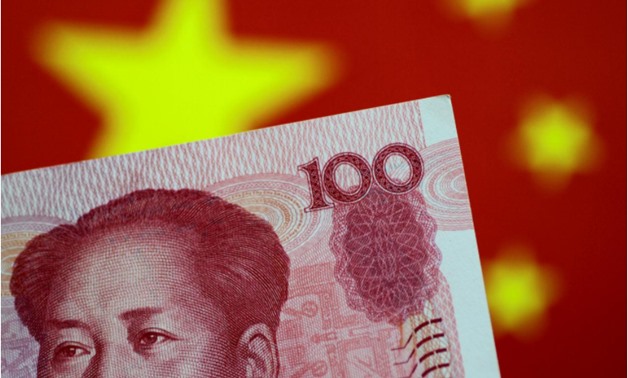
A China yuan note is seen in this illustration photo May 31, 2017 - REUTERS/Thomas White/Illustration/File Photo
SHANGHAI - 2 August 2018:China’s yuan eased against the U.S. dollar on Thursday despite a firmer official midpoint, pulled down amid the latest escalation in Sino-U.S. trade tensions.
U.S. President Donald Trump is looking to ratchet up pressure on Beijing for trade concessions by proposing a 25 percent tariff on $200 billion worth of Chinese goods.
“Besides the prospect of a protracted U.S.-China trade conflict, we would note that CNY valuations are not compelling even after the recent sell-off ... China’s share of global goods exports has trended lower,” said Jonathan Cavenagh, head of currency strategy for emerging Asia at JPMorgan Chase in Singapore.
Prior to market opening on Thursday, the People’s Bank of China increased the midpoint rate for the first time in five days to 6.7942 per dollar, 351 pips, or 0.5 percent, firmer than the previous fix of 6.8293.
In the spot market, the onshore yuan opened at 6.8080 per dollar and was changing hands at 6.8170 at midday, 20 pips weaker than the previous late session close and 0.34 percent softer than the midpoint.
Yuan traders said market sentiment had been weighed down by the renewed risk of trade war, with expectations the Chinese currency would trade in a range of 6.8 to 6.85 per dollar in the near-term.
Deutsche Bank economists said in a note that trade tensions would likely put “persistent” pressure on China’s current account in the next few years, revising their forecast for the yuan to trade at 6.95 per dollar at year-end, compared with a level of 6.8 touted previously.
They now expect the yuan to finish 2019 at 7.4.
Some market participants also noted that a firmer dollar in overseas market has put the yuan under additional downward pressure.
The U.S. Federal Reserve on Wednesday kept its interest rates unchanged as widely expected but characterised the economy as strong, keeping it on track to increase borrowing costs in September.
The global dollar index, a gauge of the unit’s strength against six other major currencies, had risen to 94.722 by midday, from the previous close of 94.624.
Market participants have speculated the yuan may be allowed to weaken more over the rest of the year as the government has so far been uncharacteristically hands-off in its approach to the rapidly declining currency.
The Thomson Reuters/HKEX Global CNH index, which tracks the offshore yuan against a basket of currencies on a daily basis, stood at 93.32, firmer than the previous day’s 93.28.
The offshore yuan was trading 0.22 percent weaker than onshore spot at 6.832 per dollar.
Trump to bump up proposed Chinese tariff
Offshore one-year non-deliverable forwards contracts (NDFs), considered the best available proxy for forward-looking market expectations of the yuan’s value, traded at 6.8608, 0.97 percent weaker than the midpoint.
One-year NDFs are settled against the midpoint, not the spot rate.


Comments
Leave a Comment